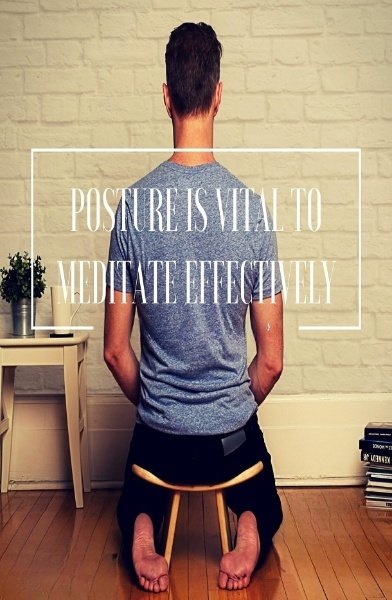Introduction
The Purpose of a Meditation Bench: Enhancing Comfort and Focus
Meditation is a journey inward, where focus and comfort are crucial to experiencing its full benefits. A meditation bench serves as an essential tool for those who struggle with sitting cross-legged or want to support their posture in a way that cushions alone may not provide. Unlike other seats, a meditation bench promotes alignment and reduces discomfort in the hips, knees, and back, allowing meditators to maintain their focus without frequent adjustments.
By easing physical strain, the right meditation bench helps create the ideal environment for both mindfulness and relaxation, empowering you to deepen your practice and experience a state of calm, centered awareness.
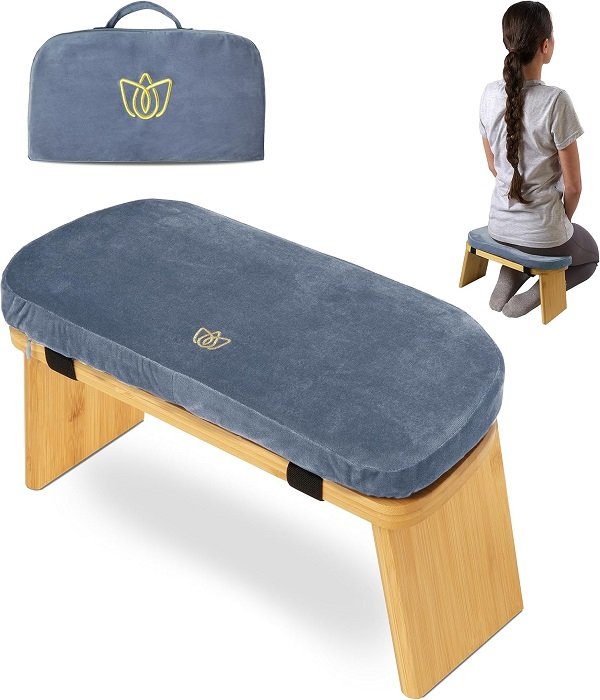
Why Choosing the Right Bench Matters for Your Meditation Practice
Selecting the right meditation bench isn’t just about aesthetics or size; it’s about choosing a tool that best supports your unique body and meditation style. Since meditation requires stillness, the wrong seating option can lead to discomfort or restlessness, interrupting the flow of your practice. When you’re comfortable, it’s easier to stay present, embrace deeper breathing, and maintain a steady mind.
A well-chosen meditation bench can thus be a small but powerful investment in creating a lasting, fulfilling meditation routine.
Who Benefits Most from Using a Meditation Bench?
Meditation benches are particularly beneficial for individuals who struggle with knee or hip pain while seated on the floor. Those who practice kneeling postures, or seiza, often find benches essential in easing pressure on joints. People who meditate outdoors may also benefit from a portable, stable bench that can adapt to various terrains.
Additionally, individuals with limited flexibility may find that a bench provides the perfect balance of comfort and stability, making longer meditation sessions easier and more sustainable.
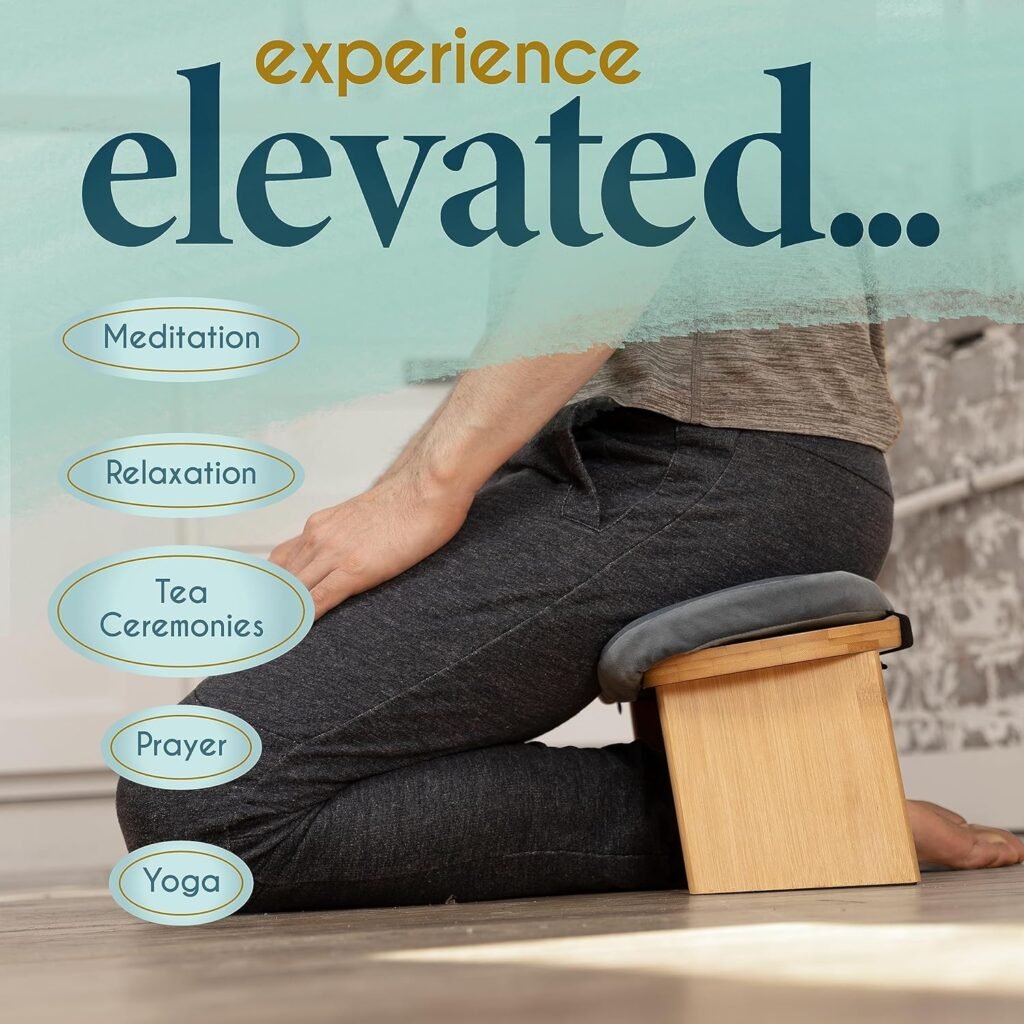
Understanding Meditation Bench Basics
What Is a Meditation Bench?
A meditation bench is a specially designed seat that helps users sit in a kneeling position, with their hips slightly elevated. This arrangement encourages natural spinal alignment and reduces tension in the legs and back. Meditation benches are generally backless, allowing your core muscles to engage and support your posture naturally. With a meditation bench, you can comfortably extend your sessions without the common distractions of aches and stiffness.
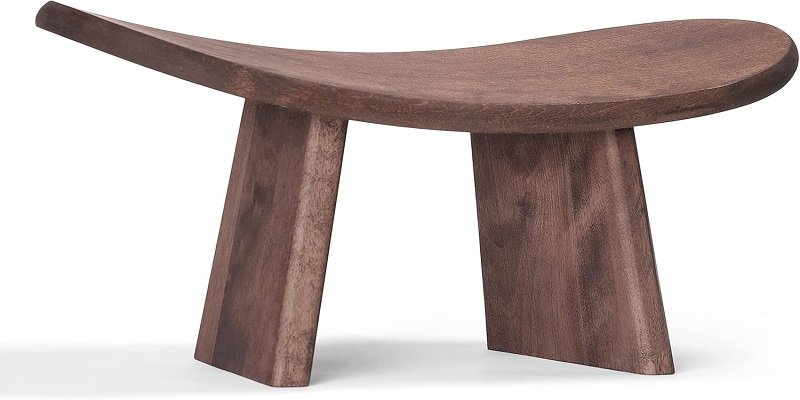
Meditation Bench vs. Other Seating Options: Cushions, Stools, and Chairs
While cushions, stools, and chairs can all provide seating for meditation, each has unique benefits and limitations. Cushions, such as zafus, are versatile and excellent for supporting various cross-legged positions. However, for those who find sitting with crossed legs challenging, a bench may offer better comfort. Meditation stools are similar to benches but are usually taller and don’t encourage the same kneeling posture that helps with alignment.
Chairs may be more accessible but often fail to provide the stability and alignment a bench can offer. Ultimately, a meditation bench strikes a balance between support and freedom, making it a popular choice for serious practitioners.
Exploring Different Meditation Postures and the Role of a Bench
Different meditation styles call for different postures. For example, Zen practitioners often sit cross-legged, while Vipassana meditators prefer kneeling. A meditation bench supports kneeling postures, such as seiza, where the bench elevates the hips slightly above the knees, allowing the spine to align effortlessly. This positioning relieves pressure from the knees and ankles while keeping the back naturally straight.
With the right bench, meditators can explore various seated postures and find what best suits their needs, making their practice more enjoyable and adaptable.
Types of Meditation Benches
Choosing the right type of meditation bench depends largely on your meditation goals, lifestyle, and comfort needs. Below, we explore the main types of meditation benches and their unique features to help you decide which one may suit your practice best.
1. Standard Meditation Bench: A Simple, Flat Design
A standard meditation bench features a straightforward design with a flat seat supported by two legs. This bench is often angled slightly to encourage a natural tilt in the pelvis, which helps align the spine comfortably. The simplicity of the standard bench makes it a popular choice for beginners and advanced meditators alike, providing a stable platform that doesn’t distract from practice.
2. Folding Meditation Bench: Portability and Convenience

For those who meditate on the go, a folding meditation bench is an ideal option. These benches are built with collapsible legs, making them easy to store and transport. A folding bench can be compactly tucked into a bag or backpack, allowing for meditation wherever you travel. Despite its portability, it remains sturdy, offering the same supportive experience as a standard bench.
3. Kneeling Meditation Bench: Supporting Natural Spine Alignment
A kneeling meditation bench is specifically designed to support the seiza, or kneeling, position. This type of bench tilts the pelvis slightly forward, encouraging a straight spine and relieving strain on the knees and ankles. If you experience discomfort in the lower back or hip flexors while meditating, a kneeling bench can offer much-needed relief and support for longer sessions.
4. Adjustable Meditation Bench: Customizing Your Comfort
An adjustable meditation bench provides versatility, allowing you to modify the seat height or angle based on your body type and posture preferences. These benches are excellent for meditators seeking a more tailored seating experience, as the adjustable features can accommodate changes in flexibility, comfort level, or even meditation posture. An adjustable bench can also adapt to various meditation techniques, making it a versatile choice.
Material Choices: Finding the Right Build
The material of your meditation bench can impact its durability, aesthetic, and comfort. Here’s a breakdown of some popular material options and what they offer.
Wooden Meditation Benches: Durability and Aesthetic Appeal

Wooden meditation benches are among the most common and preferred due to their durability and classic look. Hardwood benches, such as those made from oak or walnut, are long-lasting and can withstand frequent use. Wood also provides a warm, natural feel that enhances the meditative experience, making it a beautiful addition to any practice space.
Bamboo and Eco-Friendly Materials: Sustainable Options
For eco-conscious meditators, benches made from bamboo or other sustainable materials are excellent choices. Bamboo is a strong, lightweight, and renewable resource, often used to create benches that are both stylish and environmentally friendly. Choosing an eco-friendly bench can support your meditation practice’s alignment with sustainable living values.
Cushioned or Upholstered Benches: Added Comfort for Longer Sessions
Cushioned meditation benches feature padding on the seat, making them more comfortable for extended meditation sessions. Upholstered benches are especially beneficial for those with sensitive joints or limited flexibility, as they reduce pressure on the knees and hips. They come in a variety of fabrics and textures, so you can find one that complements both your comfort needs and style.
Size and Dimensions: Getting the Fit Right
The dimensions of your meditation bench play a vital role in achieving comfort and proper posture. Here’s what to consider.
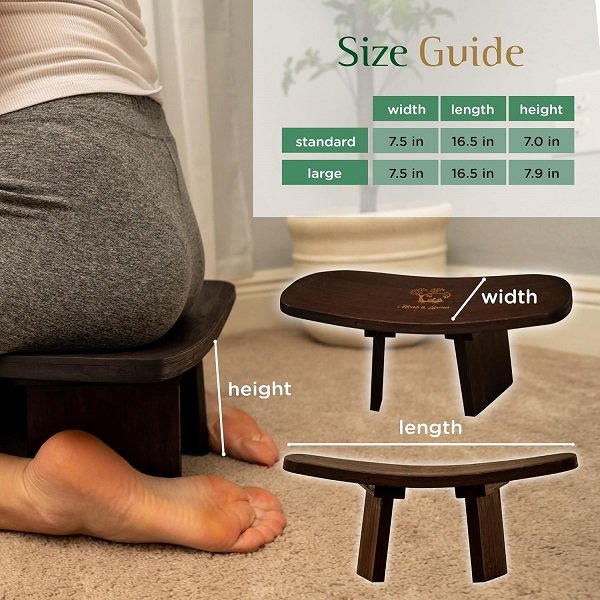
Height Considerations: How Bench Height Impacts Posture
The height of a meditation bench affects how the pelvis tilts and how weight is distributed in a kneeling position. Generally, taller benches are better suited for those with longer legs or limited flexibility, as they reduce strain on the ankles and lower back. A bench that’s too low or high may disrupt spinal alignment, so selecting an appropriate height is crucial for stability and comfort.
Seat Width and Depth: Accommodating Different Body Types
A well-sized meditation bench accommodates your body’s width and depth comfortably, allowing for natural alignment without feeling restricted. Benches with a wider seat can be helpful for larger body types, while a slightly narrower seat may be more supportive for smaller frames. Finding the right width and depth ensures you can maintain a relaxed posture without slipping or adjusting frequently.
Weight Capacity: Ensuring Safety and Stability
To ensure stability and longevity, check the bench’s weight capacity before purchasing. Most meditation benches are designed to hold a range of body weights, but if you’re on the higher end, choosing a bench with a stronger build or a higher weight capacity will provide added peace of mind and safety.
Ergonomics and Comfort
Why Ergonomics Matter in a Meditation Bench
Ergonomics are essential in a meditation bench, as proper support minimizes physical distractions during your practice. A well-designed bench aligns with the body’s natural curves, reducing strain on key areas like the lower back and knees This ergonomic focus allows for a more sustainable practice, especially during longer sessions.
Seat Angle and Knee Positioning: Optimizing for Comfort
The seat angle of a meditation bench plays a major role in knee positioning and pelvic alignment. A slight forward tilt encourages a natural curve in the spine and releases tension in the hips. The proper angle also prevents numbness in the legs by alleviating pressure on the knees, making it easier to remain comfortable and focused.
Backless Design: Supporting the Body’s Natural Curves
Meditation benches are intentionally backless to encourage active posture. The backless design requires you to engage your core muscles, promoting natural spinal alignment. This setup also provides greater freedom of movement, allowing for subtle shifts to maintain comfort without breaking focus.
Benefits of Using a Meditation Bench
1. Enhanced Focus and Reduced Discomfort
A meditation bench reduces common physical discomforts associated with seated meditation, such as knee pain, lower back strain, and numbness. By supporting a comfortable posture, a bench minimizes these distractions, allowing you to focus more fully on your meditation practice.
2. Better Posture and Alignment
Meditation benches naturally encourage proper alignment, especially for those who struggle with traditional seated postures. By keeping the spine straight and relaxed, a meditation bench helps prevent slouching or leaning, which can disrupt breathing and focus.
3. Aiding Breathing and Relaxation
With the support of a meditation bench, the body can relax more fully, and breathing can flow naturally. The improved posture provided by a bench allows for deeper, more even breaths, which promotes relaxation and a calmer mind.
Selecting a Bench Based on Meditation Style
Zen Meditation: Importance of Stability and Grounding
In Zen meditation, stability and grounding are key. A meditation bench that offers firm support helps maintain a sense of centeredness, allowing for a deeper, more grounded meditation experience. Look for benches that provide reliable stability without too much height, enhancing your connection with the earth.
Vipassana Meditation: Choosing a Bench for Extended Sessions
Vipassana meditation often involves long sessions, making comfort paramount. Benches designed for extended use, especially those with a slight forward tilt and cushioned seat, are ideal for Vipassana practitioners. An ergonomic, stable bench can help you sit for longer durations without needing to readjust.
Transcendental Meditation: Prioritizing Relaxation and Focus
For Transcendental Meditation, which focuses on relaxation and mental stillness, comfort is key. Benches with cushioned seats and slightly inclined designs support relaxation while helping to maintain a soft, gentle focus. Adjustable or upholstered benches can also enhance comfort, making it easier to let go of tension and drift into a calm state.
Matching Bench Features with Meditation Environments
Home Practice: Space and Style Considerations
When meditating at home, it’s helpful to choose a bench that fits your decor and available space. Wooden or bamboo benches can blend seamlessly into a natural or minimalist home setup. For those with limited space, a foldable bench can be easily stored and brought out for practice.
Travel-Friendly Benches: Lightweight and Foldable Options
If you meditate while traveling, a lightweight, foldable meditation bench is ideal. These benches offer portability without sacrificing support, and many foldable designs are compact enough to fit into a backpack or travel bag. Whether you meditate in hotels or outdoor settings, a travel-friendly bench can make it easy to maintain your practice on the go.
Outdoor Meditation: Durability and Weather Resistance
For those who enjoy meditating outdoors, durability is key. A meditation bench made from weather-resistant wood or treated bamboo can withstand different weather conditions. Look for benches that are sturdy yet lightweight, providing a stable seat that can handle uneven ground while connecting you to the natural world around you.
Practical Considerations and Maintenance
Beyond comfort and style, there are practical aspects to think about when choosing and caring for the right meditation bench. Proper care and budget-friendly solutions can ensure your bench supports your practice for years to come.
How to Test a Bench Before Buying (Or Choosing Online)
If you’re able to test a meditation bench in-store, try sitting on it for a few minutes in your preferred meditation posture to evaluate comfort and stability. When buying online, look for detailed descriptions of the dimensions, materials, and angle to get a sense of how it will support you. Reading user reviews for insights on comfort and quality can help you make a more informed decision.
Proper Care and Cleaning for Longevity
Maintaining your meditation bench is essential for preserving its condition. For wooden benches, wipe the surface with a damp cloth to keep it clean, and occasionally polish with a natural wood conditioner to maintain its finish. Cushioned or upholstered benches should be spot-cleaned or, if possible, vacuumed to remove dust and maintain hygiene. For bamboo and eco-friendly benches, follow specific care instructions to avoid wear and tear.
Storage Solutions for Your Meditation Bench
Storing your meditation bench properly when not in use helps prolong its life. If you have a foldable bench, consider keeping it in a meditation bag or carrying case for protection. For non-foldable benches, storing them in a dry area away from direct sunlight will help prevent fading or cracking.
Price Range and Budgeting
Meditation benches are available at various price points, and understanding the price spectrum can help you make a budget-conscious choice.
Understanding the Price Spectrum for Meditation Benches
The price of a meditation bench can vary based on the materials used, craftsmanship, and features like adjustability. Entry-level benches are often under $50, while premium benches, typically made from high-quality wood or featuring custom designs, can go over $150.
Are Premium Benches Worth the Investment?
If you meditate regularly or for extended periods, investing in a high-quality bench can pay off in durability and comfort. Premium benches tend to use materials that offer better support and may include additional features, such as adjustability and cushioning, which are particularly beneficial for longer sessions.
Balancing Quality and Budget for Beginners and Advanced Meditators
As a beginner, starting with a reasonably priced bench might be best until you establish your preferred meditation style. Experienced meditators may appreciate the additional support and comfort a higher-end bench provides, especially if it enhances focus and stability.
Making an Informed Decision
To finalize your choice, consider reviews, customization options, and reputable brands.
Evaluating Product Reviews and User Feedback
Reading customer reviews and user feedback can offer insights into the bench’s durability, comfort, and functionality. Look for specific comments on aspects like stability, seat angle, and material quality to better gauge if it’s the right meditation bench for your needs.
Choosing Between Custom-Made and Store-Bought Benches
Custom-made benches can offer a tailored experience, especially for those with unique body types or posture preferences. Store-bought options, however, provide more standardized sizing and may be easier to return or exchange. Weigh the pros and cons based on your specific needs and budget.
Popular Brands and Reputable Sources for Meditation Benches
Some popular and reputable brands for meditation benches include Still Sitting, Peace Bench, and Mindful & Modern. Choosing from trusted sources can ensure quality and satisfaction with your purchase, as well as reliable customer support if needed.
Summary
Key Takeaways for Choosing the Right Meditation Bench
Choosing the right meditation bench involves considering factors like material, size, comfort, and ergonomics. By matching the bench to your posture preferences, environment, and meditation style, you can find a bench that supports your practice and enhances your focus.
How a Well-Chosen Bench Can Improve Your Practice
The right meditation bench can make a noticeable difference in your meditation experience, helping you maintain good posture, reduce physical discomfort, and focus on your breathing and relaxation. A comfortable and supportive bench encourages a more consistent and fulfilling practice.
Next Steps: Starting Your Meditation Journey with Confidence
Now that you’re equipped with the knowledge to choose a suitable meditation bench, explore different options with confidence and begin your journey to deeper and more rewarding meditation sessions.
FAQs
How do I know which bench height is right for me?
The right height depends on your body proportions and preferred posture. If your knees are higher than your hips when seated, try a taller bench. For optimal alignment, your hips should be slightly higher than your knees.
Can meditation benches help reduce back pain?
Yes, meditation benches are designed to promote natural spinal alignment, which can help reduce lower back strain and pain during meditation by supporting proper posture.
Are there specific benches recommended for outdoor use?
Yes, look for benches made from durable, weather-resistant materials like treated wood or bamboo for outdoor use. Foldable options also offer easy portability for outdoor meditation.
What are the best practices for cleaning a meditation bench?
For wooden benches, wipe with a damp cloth and polish occasionally. Cushioned benches should be spot-cleaned or vacuumed. Follow manufacturer care instructions for bamboo or other specific materials.
Should I choose a bench or a cushion for longer meditation sessions?
Both are good options, but a bench provides more support for those who experience discomfort in the knees or back. Cushions can also be effective if they offer sufficient height and firmness for your posture.
Take Your Learning to the Next Level:
Meditation Pillows Bamboo Pillow Anti-Allergy Pillows
Aromatherapy Pillows Natural Latex Pillows Organic Cotton Pillows

